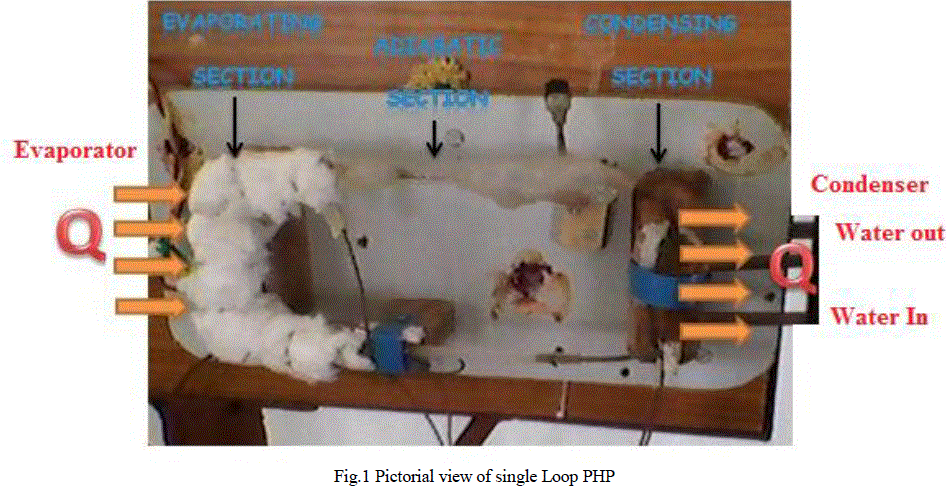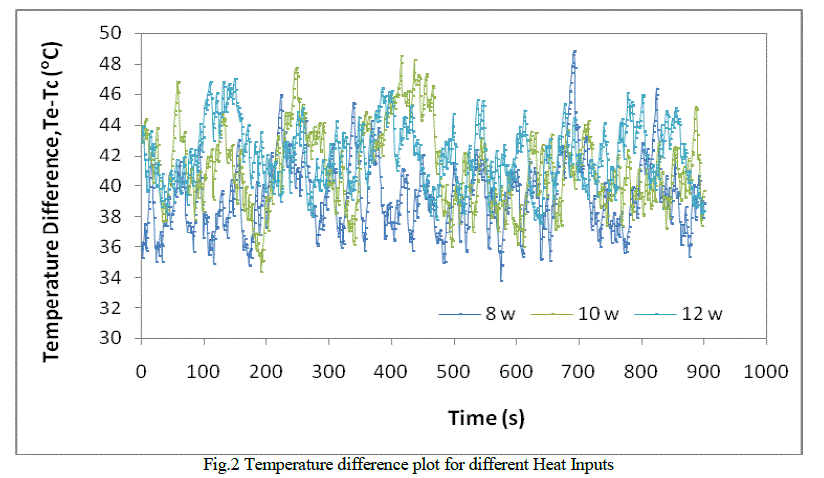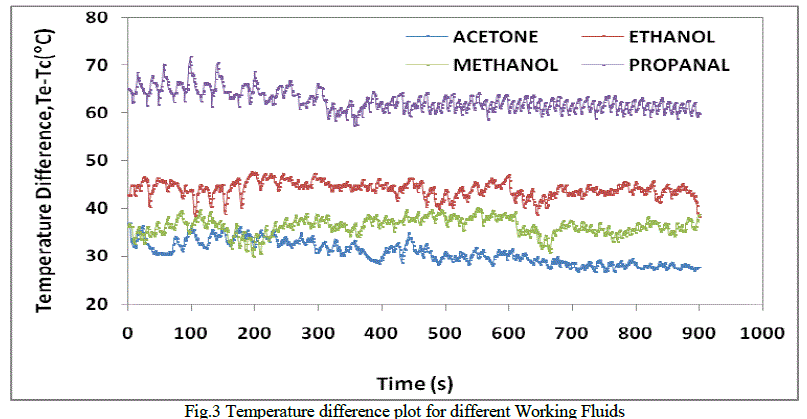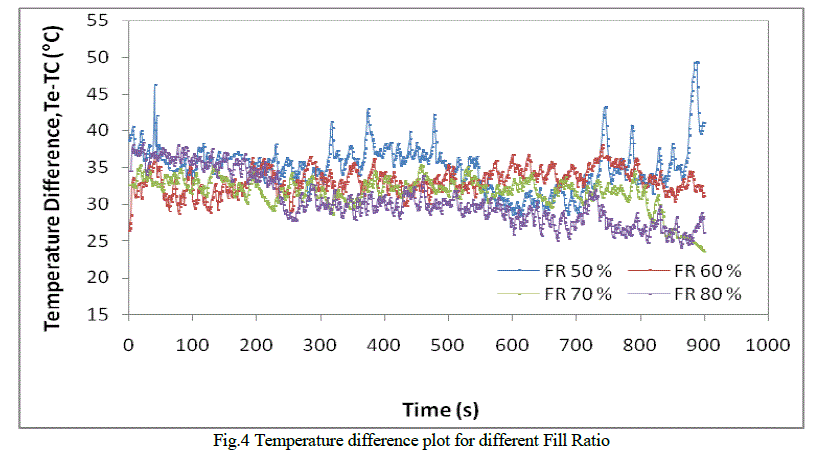ISSN ONLINE(2319-8753)PRINT(2347-6710)
ISSN ONLINE(2319-8753)PRINT(2347-6710)
R.R.Uday Kumar1, Umashankar2 and Ch.Sreenivasa Rao3
|
| Related article at Pubmed, Scholar Google |
Visit for more related articles at International Journal of Innovative Research in Science, Engineering and Technology
Advancement is taking place in electronic field of engineering and increasing the demand for of smaller and effective heat transfer devices. Several cooling methods are employed to cool the electronic devices. Pulsating heat pipe (PHP) is a passive two-phase heat transfer device for handling moderate to high heat fluxes typically suited for power electronics and similar applications. It usually consists of a small diameter tube, closed end-to-end in a loop, evacuated and then partially filled with a working fluid. Heat transfer is through natural oscillations of the working fluid between the evaporator and condenser sections. In the present work, the experimental studies are carried out on a single loop PHP for the variation of applied heat flux, filling ratio and working fluids. The performance parameters of PHP like thermal resistance and heat transfer coefficient are would be evaluated for the above conditions
Keywords |
| Working Fluid, Fill Ratio, Heat Input, Pulsating Heat Pipe, Thermal Resistance, Heat Transfer Coefficient. |
INTRODUCTION |
| Nowadays, there is a lot of equipment or parts inside machines called heating elements need to be cooled during working process, especially with electrical or electronic devices. About their size, manufacturers are minifying with every passing day in order to satisfy requirements of users but the power must be maintained. This makes elements stand a high amount of heat, that is, high heat flux would be generated during working process. Therefore, there is a need of professional component to cool heating elements so that maintain their appropriate temperature and that is the maintenance of their longevity. However, with many actual cases, one saw that it is difficult to arrange a cooling device near the heating elements so that can rapidly decrease the heat amount that is generating. |
| A pulsating heat pipe or oscillating heat pipe has best potential to handle the above problem. It is simple in structure with a coil filled with certain working fluid in it and extended from the heat source to sink. The working fluid transfer by means of differential pressure across vapour plugs from evaporator to condenser and back. The vapour formed at the evaporator is pushed towards the condenser in the form of discrete vapour bubbles amidst pockets of fluid. The vapour gets condensed at the condenser and gives the heat and returns to evaporator to complete the cycle. The heat transfer in a PHP is due to the sensible heat and latent heat combination. |
BACKGROUND |
| PHP, first proposed by Akachi [1] as a passive cooling device is gaining attention of many investigators. Further the mathematical models proposed in the literature on PHP require experimental verification [2, 3 and 4]. In a few experimental investigations, the operational limits and behavior in PHP have been measured and reported [5and6]. In a few experimental investigations, the temperature variations in multiple-loop PHP have been measured and reported [7, 8, 9, 10 and 11]. Results of single loop PHP are also reported in few literatures [12, 13, 14, 15, 16, 17, 18 and 19]. The pattern of temperature variation and the related effect on the performance of PHP is to be explored in the light of physics. The pulsating motion of the fluid in a PHP warrants detailed investigations. The effect of working fluid and fill ratio on the performance of PHP is another area which requires detailed investigation. |
| Both experimental and numerical investigations on php’s and their performance are reported in the literature though not in sufficient numbers. The experimental investigations mainly focus on flow visualization and measurement of temperature. Numerical investigations deal with various php models and performance evaluation. |
SCOPE OF RESEARCH |
| In the present investigations, fluids like acetone, methanol, ethanol and Propanal are considered, the transient and steady state experiments are carried out for single loop PHP made of brass (Φ2mm). Various performance indicators such as thermal resistance and heat transfer coefficient are evaluated and analysed for different heat loads and fill ratios. |
EXPERIMENTATION |
| Fig.1.shows the experimental setup of PHP. The basic components used in PHP are brass tubes, glass tubes, silicon rubber tubes, a non return valve, a tape heater and thermocouples. Since brass is a good conductor of heat, it is used as the capillary tube material in the evaporator and condenser sections with inner diameter of 2 mm and outer diameter of 2.5 mm. |
 |
| In order to visualize the fluid flow in the PHP, a glass tube is connected between U turn brass tubes for a length of 75 mm. Silicon rubber tubes of 2 mm inner diameter and 4 mm outer diameter are used as connectors between glass and copper tubes, both in the evaporator and condenser section. The silicon rubber tubes are employed as connectors because they are thermal insulators and can withstand high temperatures up to 4000 0 C. They are leak proof and expand at higher temperatures. In order to maintain unidirectional fluid flow, a non-return valve is used. The valve is made of stainless steel and has inner diameter of 5mm. |
| Six K- type thermocouples are used for temperature measurement. The thermocouples can measure temperature up to 1260° C. The wire diameter of the thermocouples is 1mm and four thermocouples are connected in the evaporator section and four in condenser section at equal distances. A temperature data logger is used to record the temperatures at different locations. The measurement has inherent uncertainties. The thermocouple temperature display system has an uncertainty of ± 2% of full scale. The manual reading of temperature with varying time contains an error of about 1% of reading. |
| A tape heater capacity of 25 W is attached to the evaporator section and acts as the source of heat input. The experimental setup is worked with four working fluids viz., Acetone, methanol, ethanol and Propanal. The working fluid is injected into the heat pipe using a syringe. |
EXPERIMENTAL PROCEDURE |
| The experimental setup shown in Fig.1.The following procedure is adopted conducting the present transient experiment: |
| 1. Before filling the working fluid, it is ensured that there is no other fluid exists inside the tubes of PHP. |
| 2. The required amount of working fluid is then filled through a syringe by opening one end of the non-return valve such that the fluid directly enters the evaporator section. |
| 3. Now the air is filled through the filling valve provided on the brass tube using another syringe. This is done to ensure simultaneous formation of liquid slug and vapour plug. |
| 4. The cooling water is allowed to the condenser section of PHP from the constant water bath and the amount of cooling water is controlled in such a way that the temperature rise of cooling water in the condenser is always between 10 C to 20 C. |
| 5. The temperature data logger is then switched on to record the temperature readings. |
| 6. The required wattage is set using the power supply unit. In the present work, the experiments were conducted by varying the heat inputs from 8 W to 12 W in steps of 1 W. |
| 7. Transient experiments are conducted with different working fluids viz. acetone, ethanol methanol and propanal and the various temperatures are recorded with the help of data logger. The experiments are continued till steady state is reached. |
RESULTS AND DISCUSSION |
A. Effect of Heat Input on Temperature difference |
| Fig.2 shows the plot of temperature difference with time for Methanol at 50% fill ratio at different heat inputs. |
| From this figure.2 it is absorbed that when the heat input (Q) is increased the temperature difference between evaporator and condenser will increased. As at the low heat inputs the movement of fluid is very slow and the difference in temperature between evaporator and condenser is less at lower heat inputs. |
 |
B. Effect of Working Fluid on Temperature difference |
| Fig.3.Shows the plot of temperature difference with time for different working fluids at 70% fill ratio at 10w heat input From this figure.3 it is absorbed that temperature difference between the evaporator and condenser is less for acetone compared to other working fluids because of saturation temperature of acetone is lower compared to other working fluids. The fluctuations are also very less. This shows that acetone can transfer heat with less temperature difference and the temperature is around 310 C. |
 |
D. Effect of Working Fluid on Thermal Resistance |
| Fig.5 shows the plot of thermal resistance with heat input for different working fluid at 60 % fill ratio. From the figure.5 it is clear that the thermal resistance decreases with increases in heat input. As the temperature difference between evaporator and con denser is less for acetone, the thermal resistance is also very less. It indicates that acetone is best working fluid compared to other working fluids in heat transfer capability. |
 |
CONCLUSION |
| In the present work, the experimental investigations are carried out on a single loop PHP. The effects of heat input, working fluid and fill ratio on the performance of PHP are studied. The results of the present study are summarized as follows: |
| • The temperature difference between evaporator and condenser is lower for acetone compared to other working fluids. |
| • When heat input increases the thermal resistance will decreases and heat transfer coefficient will be increases. |
| • When heat input increases the fluid circulation velocity is also increases. |
| • Acetone is the most suitable working fluid for PHP operation when compared to other working fluid. |
References |
|